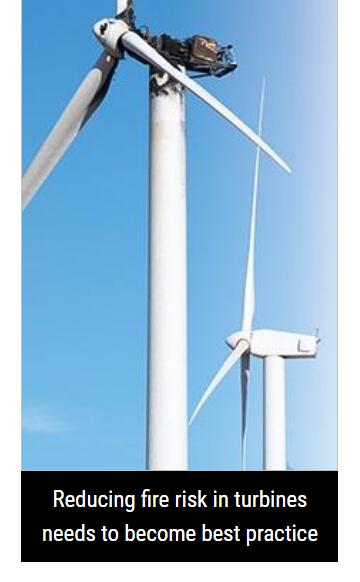Welcome to Sino Bearings web
24x7 HOTLINE:+86-28-81454188

 NEWS
NEWS
Angela Krcmar explains why wind farm owners and operators must go beyond recommendations to manage fire risk
The wind industry has seen phenomenal growth over the past decade. With the current US government having campaigned to support this sector’s growth to help decarbonise its national energy supply, there is good reason for optimism among wind farm owners and operators.
However, as renewables comes onto the federal agenda, windpower has to be prepared for additional scrutiny and potential regulations around key risks in line with other energy sectors.
Fire is a particularly high-visibility problem for the industry – and can provide fuel for anti-wind campaigning and distrust among local stakeholders. To make the most of the current support for wind energy, project owners need to ensure that fire risk is fully managed even beyond what is currently regulated.
How do fires ignite on wind farms?
Wind turbines can catch fire due to external causes such as lightning, but also as a result of internal malfunctions. Electrical failures can generate arc flashes, which are the second most common cause of fires in the nacelle after lightning. If a gearbox overheats, the combination of mechanical friction and heat can create a tinderbox inside the wind turbine.
If the nacelle catches fire, this can result in significant damage to the whole turbine. The average hub height of a current turbine exceeds 250ft, putting the nacelle well out of range for ground-based firefighting. However, sending a team up the tower to manually fight the fire constitutes a major health and safety risk, and as such, nacelle fires are often left to burn out, damaging the turbine beyond repair. Replacing a modern wind turbine after a fire can cost owners US$7-8 million and up to a year of lost revenue.
The scale of turbine fires at wind farms
A lack of transparency in the wind industry around turbine fires has resulted in particular confusion when it comes to the relative risk of a turbine catching fire. Current estimates suggest that a fire could be as rare as 1 in 15,000 turbines, or as common as 1 in 2,000 turbines. Data from the insurance industry suggests that 1 in 4,000 turbines catch fire per year – although these figures were collated in 2014. As new designs come to market, and existing turbines age, fire risk is likely to have increased.
Even with conservative estimates in mind, as more and more turbines are built, rare events such as turbine fires could become more common due to the “law of very large numbers”, or the principle that even an event with a rare probability of occurring is likely to happen if the sample size is large enough.
There are currently nearly 60,000 turbines operating in the USA – as such, if we apply a 1 in 2,000 chance of a turbine fire to this sample size, we can expect 30 turbine fires in a given year – and 1-2 turbine fires in an average 150-turbine wind farm. If the national fleet reaches 120,000 turbines, this doubles the number of turbine fires expected in a given year – even if the risk and probability of a turbine fire has remained the same.
As such, the wind industry must ensure continued reduction of risk alongside the expected growth in the coming years – or face backlash and stricter regulation due to increased visibility of wind turbine fires.
Current wind farm regulations
All power plants across the USA must comply with National Fire Protection Association (NFPA) standards to ensure their operations are sufficiently safe. Coal, gas and nuclear are all regulated to ensure that sufficient fire detection and suppression systems are installed to guarantee the safety of staff onsite.
NFPA 850, the code for fire safety in power generation, does provide recommendations for wind turbine fire safety. However, fire detection and suppression systems are only recommended, and not required for either new or operational projects.
Although national fire codes are still behind the curve with recommendations for wind turbines, local authorities are already taking legal action and mandating the installation of fire protection for sites even before fires occur. In the state of New Hampshire, for example, a legal dispute was sparked between the fire marshal and a leading utility over whether a wind farm in a forested area was following the state’s fire code and was only resolved by the retrofitting of fire suppression systems to prevent the worst-case scenario of a wildfire.
As with the case in New Hampshire, this kind of legal action is more likely to occur if a wind turbine fire could spread into the environment. Legal challenges in the event of a wildfire can bankrupt companies found to be at fault for any subsequent damages.
Outside the USA, following a number of high-profile wind turbine fires, countries such as Germany and Canada’s Ontario province have already mandated fire suppression for new projects, and in the latter’s case, also require fire suppression to be retrofitted to existing sites.
Fire causes not only considerable financial damage to wind farm owners and operators but can also destroy their rightful reputation as providers of safe green energy. The industry must ensure it is not just sticking to the bare minimum of recommendations, but actively encouraging best practice for reducing fire risk, from adjusting operational guidelines to mitigate mechanical or electrical failures to installing technology to put fires out when they do start.